Contents
- 1. Manual
- 2. User Manual
User Manual
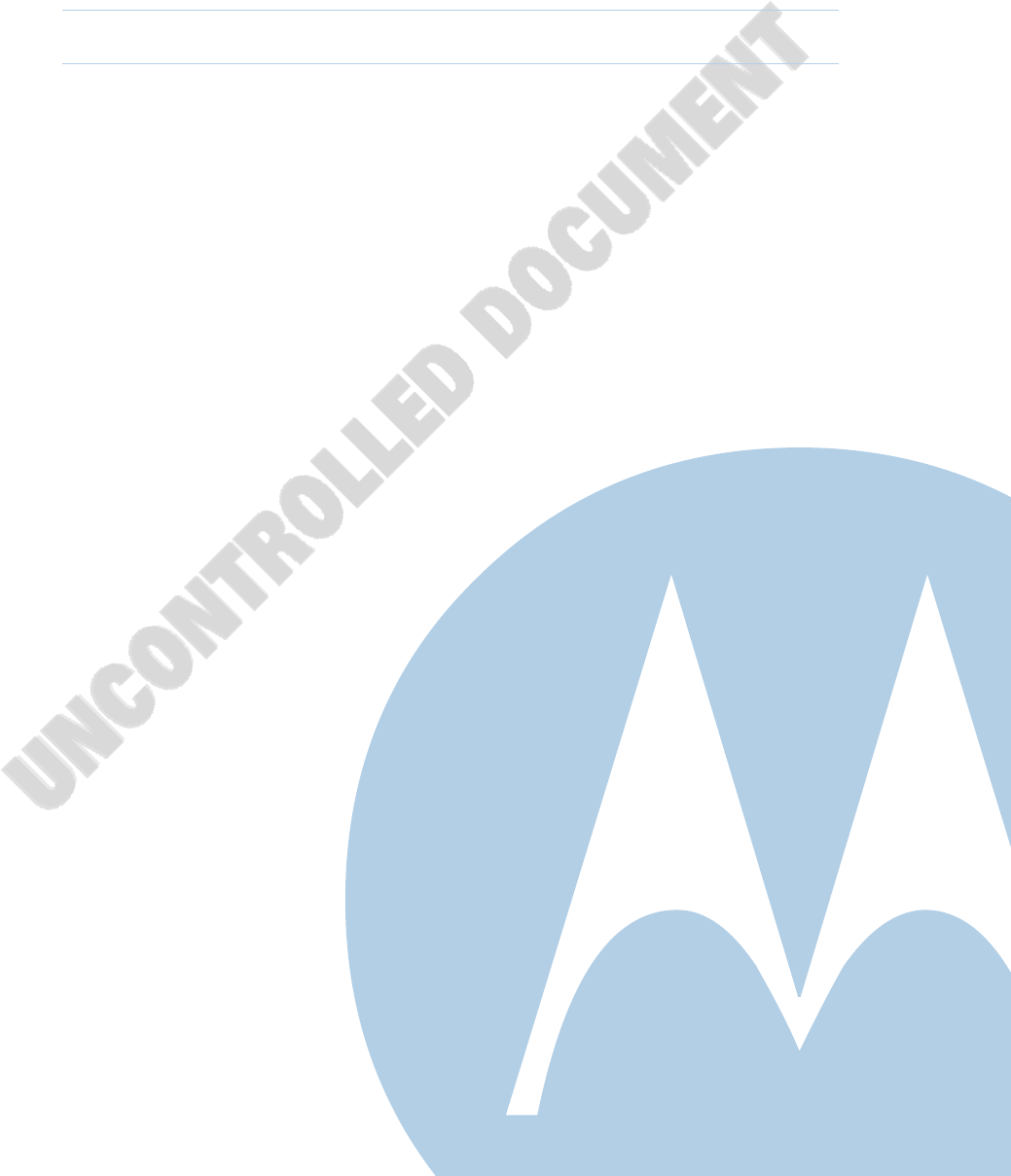
M
User Guide
Motorola SURFboard®
SVG2501 Series Wireless Voice Gateway*
*SVG2501
SVG2501U

B
© 2009 Motorola, Inc. All rights reserved. No part of this publication may be reproduced in any form or by any means or
used to make any derivative work (such as translation, transformation, or adaptation) without written permission from
Motorola, Inc.
Motorola reserves the right to revise this publication and to make changes in content from time to time without
obligation on the part of Motorola to provide notification of such revision or change. Motorola provides this guide without
warranty of any kind, implied or expressed, including, but not limited to, the implied warranties of merchantability and
fitness for a particular purpose. Motorola may make improvements or changes in the product(s) described in this manual
at any time.
Motorola and the Stylized M logo are registered trademarks of Motorola, Inc. All other product or service names are the
property of their respective owners.

Motorola SURFboard SVG2501 Series Wireless Voice Gateway* • User Guide ii
550885-001-a
Contents
Safety and Regulatory Information
Introduction
Inside the Box.................................................................................................................................. 1
Contact Information ......................................................................................................................... 2
Minimum System Requirements .................................................................................................... 2
Product Overview
Front Panel....................................................................................................................................... 3
Rear Panel........................................................................................................................................ 4
MAC Label ....................................................................................................................................... 5
Cabling the Gateway
Installing the Battery........................................................................................................................ 6
Connecting the SVG2501 ................................................................................................................ 7
Connecting the SVG2501U.............................................................................................................. 9
Wall Mounting the Gateway.......................................................................................................... 10
Wall Mounting Template......................................................................................................... 11
Connecting to the Internet
Before You Begin........................................................................................................................... 13
Configuring TCP/IP for Windows XP ............................................................................................. 13
Configuring TCP/IP for Windows Vista.......................................................................................... 14
Verifying the IP Address ................................................................................................................ 14
Windows XP............................................................................................................................ 14
Windows Vista ........................................................................................................................ 15
Renewing the IP Address in Windows XP or Vista ....................................................................... 15
Setting Up a Wi-Fi Network........................................................................................................... 16
Using the Configuration Manager
Starting the Gateway Configuration Manager ............................................................................... 17
Menu Options ......................................................................................................................... 18
Changing the Default Username and Password ........................................................................... 19
Restoring the Default Username and Password ........................................................................... 19
Saving Your Gateway Configuration .............................................................................................. 20
Restoring Your Gateway Configuration ......................................................................................... 20
Retrieving Help .............................................................................................................................. 20
Exiting the Gateway Configuration Manager................................................................................. 21
Troubleshooting
Solutions ........................................................................................................................................ 22
Front Panel LEDs and Error Conditions ......................................................................................... 23

Motorola SURFboard SVG2501 Series Wireless Voice Gateway* • User Guide iii
550885-001-a
Software License & Warranty
Software License........................................................................................................................... 24
Warranty Information..................................................................................................................... 25

Motorola SURFboard SVG2501 Series Wireless Voice Gateway* • User Guide iv
550885-001-a
i Safety and Regulatory Information
IMPORTANT SAFETY INSTRUCTIONS
Read This Before You Begin
When using your telephone equipment, basic safety precautions should always be followed to reduce the risk of fire,
electric shock, and injury to persons, including the following:
• Read all of the instructions listed here and/or in the user manual before you operate this device. Give particular
attention to all safety precautions. Retain the instructions for future reference.
• This device must be installed and used in strict accordance with manufacturer’s instructions, as described in the user
documentation that is included with the device.
• Comply with all warning and caution statements in the instructions. Observe all warning and caution symbols that
are affixed to this device.
• To prevent fire or shock hazard, do not expose this device to rain or moisture. The device must not be exposed to
dripping or splashing. Do not place objects filled with liquids, such as vases, on the device.
• This device was qualified under test conditions that included the use of the supplied cables between system
components. To ensure regulatory and safety compliance, use only the provided power and interface cables and
install them properly.
• Different types of cord sets may be used for connections to the main power supply circuit. Use only a main line cord
that complies with all applicable device safety requirements of the country of use.
• Installation of this device must be in accordance with national wiring codes and conform to local regulations.
• Operate this device only from the type of power source indicated on the device’s marking label. If you are not sure of
the type of power supplied to your home, consult your dealer or local power company.
• Do not overload outlets or extension cords, as this can result in a risk of fire or electric shock. Overloaded AC outlets,
extension cords, frayed power cords, damaged or cracked wire insulation, and broken plugs are dangerous. They may
result in a shock or fire hazard.
• Route power supply cords so that they are not likely to be walked on or pinched by items placed upon or against
them. Pay particular attention to cords where they are attached to plugs and convenience receptacles, and examine
the point where they exit from the device.
• Place this device in a location that is close enough to an electrical outlet to accommodate the length of the power
cord.
• Place the device to allow for easy access when disconnecting the power cord of the device from the AC wall outlet.
• Do not connect the plug into an extension cord, receptacle, or other outlet unless the plug can be fully inserted with
no part of the blades exposed.
• Place this device on a stable surface.
• It is recommended that the customer install an AC surge protector in the AC outlet to which this device is connected.
This is to avoid damaging the device by local lightning strikes and other electrical surges.
• Postpone installation until there is no risk of thunderstorm or lightning activity in the area.
• Avoid using a telephone (other than a cordless type) during an electrical storm. There may be a remote risk of
electric shock from lightning. For added protection, unplug the device from the wall outlet and disconnect the cables
to avoid damage to this device due to lightning and power surges.
• Do not use this product near water: for example, near a bathtub, washbowl, kitchen sink or laundry tub, in a wet
basement, or near a swimming pool.

Motorola SURFboard SVG2501 Series Wireless Voice Gateway* • User Guide v
550885-001-a
• Do not use the telephone to report a gas leak in the vicinity of the leak.
• Use only the power cord and batteries indicated in this manual. Do not dispose of batteries in a fire. They may
explode. Check with local codes for possible special disposal instructions.
• Disconnect TNV circuit connector(s) before disconnecting power.
• Disconnect TNV circuit connector before removing cover.
• Do not cover the device or block the airflow to the device with any other objects. Keep the device away from
excessive heat and humidity and keep the device free from vibration and dust.
• Wipe the device with a clean, dry cloth. Never use cleaning fluid or similar chemicals. Do not spray cleaners directly
on the device or use forced air to remove dust.
• CAUTION: To reduce the risk of fire, use only No. 26 AWG or larger (e.g., 24 AWG) UL Listed or CSA Certified
Telecommunication Line Cord, or national equivalent.
• Upon completion of any service or repairs to this device, ask the service technician to perform safety checks to
determine that the device is in safe operating condition.
• Do not open the device. Do not perform any servicing other than that contained in the installation and
troubleshooting instructions. Refer all servicing to qualified service personnel.
• This device should not be used in an environment that exceeds 40º C.
SAVE THESE INSTRUCTIONS
Note to CATV System Installer: This reminder is provided to call the CATV system installer’s attention to Section
820.93 of the National Electric Code, which provides guidelines for proper grounding and, in particular, specifies that
the coaxial cable shield shall be connected to the grounding system of the building, as close to the point of cable entry
as practical.
Caring for the Environment by Recycling
When you see this symbol on a Motorola product, do not dispose of the product with residential or commercial
waste.
Recycling your Motorola Equipment
Please do not dispose of this product with your residential or commercial waste. Some countries or regions, such as
the European Union, have set up systems to collect and recycle electrical and electronic waste items. Contact your
local authorities for information about practices established for your region. If collection systems are not available,
call Motorola Customer Service for assistance. Please visit www.motorola.com/recycle for instructions on recycling.
SAFETY REQUIREMENTS FOR THE SVG2501 LITHIUM-ION BATTERY
You must properly handle the SVG2501 lithium-ion rechargeable battery to ensure your safety. Improper handling can
cause leakage, heat, smoke, explosion, or fire resulting in damage to the equipment or the user.
• Use the SVG2501 battery only in the SVG2501 Series Wireless Voice Gateway.
• CAUTION: Risk of explosion if battery is replaced by the incorrect type. Use only Motorola approved batteries.
Dispose of used batteries according to the instructions.
• Do not use the battery where static electricity is generated.
• Do not heat the battery or discard into a fire. Keep the battery away from high-temperature locations.
• Properly discard the battery if it exhibits an abnormal condition, such as heat, odor, color, or a change in shape.
When discarding, place insulated tape over the battery terminals.
• The battery should be stored out of the reach of children.
• Do not store the battery close to metal objects.

Motorola SURFboard SVG2501 Series Wireless Voice Gateway* • User Guide vi
550885-001-a
• If the battery leaks fluid and you touch it, immediately wash your hands. If the fluid gets into your eye, do not rub the
eye. Rinse with water and immediately seek medical care. Left untreated, the battery fluid could cause damage to
the eye.
• Ensure that the battery does not receive any strong impacts, such as dropping or striking with a hard object.
• At the end of battery life, the SVG2501 battery must be disposed of properly and may need to be recycled. Contact
your local recycling center for proper disposal methods.
• Do not disassemble, modify, or attempt to repair the battery.
• Before installation, the battery should not be subjected to temperatures below –10º C or above +60º C (14º F to 140º
F). After initial customer usage (initially charged above shipping charge state), the battery should not be subjected to
temperatures outside the operating temperature range:
Battery Pack External Exposure Operating Temperature Range:
• Charging: 0.0° C to +45.0° C (0º F to 113º F)
• Discharging: –10.0° C to +60.0° C (14º F to 140º F)
Important VoIP Service Information
Please contact your Internet Service Provider (ISP) and/or your local municipality for additional
information on making emergency calls using VoIP service in your area.
When using this VoIP device, you CANNOT make any calls, including an emergency call and emergency
location services (where supported) WILL NOT be available, under the following circumstances:
• Your broadband ISP connection goes down, is lost, or otherwise fails.
• You lose electrical power.
• You have changed the physical address of your VoIP device, and you did not update or otherwise
advise your VoIP service provider of this change.
• There are delays in making your location information available in or through the local automatic
location information database.
Note: Your service provider, not Motorola, is responsible for the provision of VoIP telephony services through this
equipment. Motorola shall not be liable for, and expressly disclaims, any direct or indirect liabilities, damages, losses,
claims, demands, actions, causes of action, risks, or harms arising from or related to the services provided through this
equipment.
FCC STATEMENTS
FCC Interference Statement
This equipment has been tested and found to comply with the limits for a Class B digital device, pursuant to part 15 of
the FCC Rules. These limits are designed to provide reasonable protection against harmful interference in a residential
environment. This equipment generates, uses, and can radiate radio frequency energy and, if not installed and used in
accordance with the instructions, may cause harmful interference to radio communications. However, there is no
guarantee that interference will not occur in a particular installation. If this equipment does cause harmful interference
to radio or television reception, which can be determined by turning the device off and on, the user is encouraged to try
to correct the interference by one or more of the following measures:
• Reorient or relocate the receiving antenna.
• Increase the separation between the device and receiver.
• Connect the equipment into an outlet on a circuit different from that to which the receiver is connected.
• Consult the dealer or an experienced radio/TV technician for help.

Motorola SURFboard SVG2501 Series Wireless Voice Gateway* • User Guide vii
550885-001-a
This device complies with part 15 of the FCC Rules. Operation is subject to the following two conditions: (1) This device
may not cause harmful interference, and (2) This device must accept any interference received, including interference
that may cause undesired operation.
FCC CAUTION: Any changes or modifications not expressly approved by Motorola for compliance could void the user’s
authority to operate the equipment.
• United States Federal Communications Commission, Code of Federal Regulations; Rule Part 47CFR § 2.1093 sub-part
J:1999
• International Commission on Non-Ionizing Radiation Protection (ICNIRP) 1998
• Ministry of Health (Canada) Safety Code 6. Limits of Human Exposure to Radio frequency Electromagnetic Fields in
the Frequency Range from 3 kHz to 300 GHz, 1999
• Institute of Electrical and Electronic Engineers (IEEE) C95.1-2005 Edition
FCC Radiation Exposure Statement
This equipment complies with FCC radiation exposure limits set forth for an uncontrolled environment. To comply with
the FCC RF exposure compliance requirements, the separation distance between the antenna and any person’s body
(including hands, wrists, feet, and ankles) must be at least 20 cm (8 inches).
This transmitter must not be co-located or operating in conjunction with any other antenna or transmitter.
The availability of some specific channels and/or operational frequency bands are country dependent and are firmware
programmed at the factory to match the intended destinations. The firmware setting is not accessible by the end user.
INDUSTRY CANADA (IC) STATEMENT
This device complies with RSS-210 of the Industry Canada Rules. Operation is subject to the following two conditions:
• This Device May Not Cause Interference, and
• This Device Must Accept Any Interference, Including Interference That May Cause Undesired Operation of the
Device.
This Class B digital apparatus complies with Canadian ICES-003.
Cet appareil numérique de la classe B est conforme à la norme NMB-003 du Canada.
IC Radiation Exposure Statement
IMPORTANT NOTE: This equipment complies with IC radiation exposure limits set forth for an uncontrolled
environment. This equipment should be installed and operated with a minimum distance of 20 cm (8 inches) between
the radiator and your body.
WIRELESS LAN INFORMATION
This device is a wireless network product that uses Direct Sequence Spread Spectrum (DSSS) and Orthogonal
Frequency-Division Multiple Access (OFDMA) radio technologies. The device is designed to be interoperable with any
other wireless DSSS and OFDMA products that comply with:
• The IEEE 802.11 Standard on Wireless LANs (Revision B and Revision G), as defined and approved by the Institute of
Electrical and Electronics Engineers
• The Wireless Fidelity (Wi-Fi) certification as defined by the Wireless Ethernet Compatibility Alliance (WECA).

Motorola SURFboard SVG2501 Series Wireless Voice Gateway* • User Guide viii
550885-001-a
Restrictions on the Use of Wireless Devices
In some situations or environments, the use of wireless devices may be restricted by the proprietor of the building or
responsible representatives of the organization. For example, using wireless equipment in any environment where the
risk of interference to other devices or services is perceived or identified as harmful.
If you are uncertain of the applicable policy for the use of wireless equipment in a specific organization or environment,
you are encouraged to ask for authorization to use the device prior to turning on the equipment.
The manufacturer is not responsible for any radio or television interference caused by unauthorized modification of the
devices included with this product, or the substitution or attachment of connecting cables and equipment other than
specified by the manufacturer. Correction of the interference caused by such unauthorized modification, substitution, or
attachment is the responsibility of the user.
The manufacturer and its authorized resellers or distributors are not liable for any damage or violation of government
regulations that may arise from failing to comply with these guidelines.
SECURITY WARNING: This device allows you to create a wireless network. Wireless network connections may be
accessible by unauthorized users. For more information on how to protect your network, see the section on setting up
your wireless LAN in this guide or visit the Motorola website.
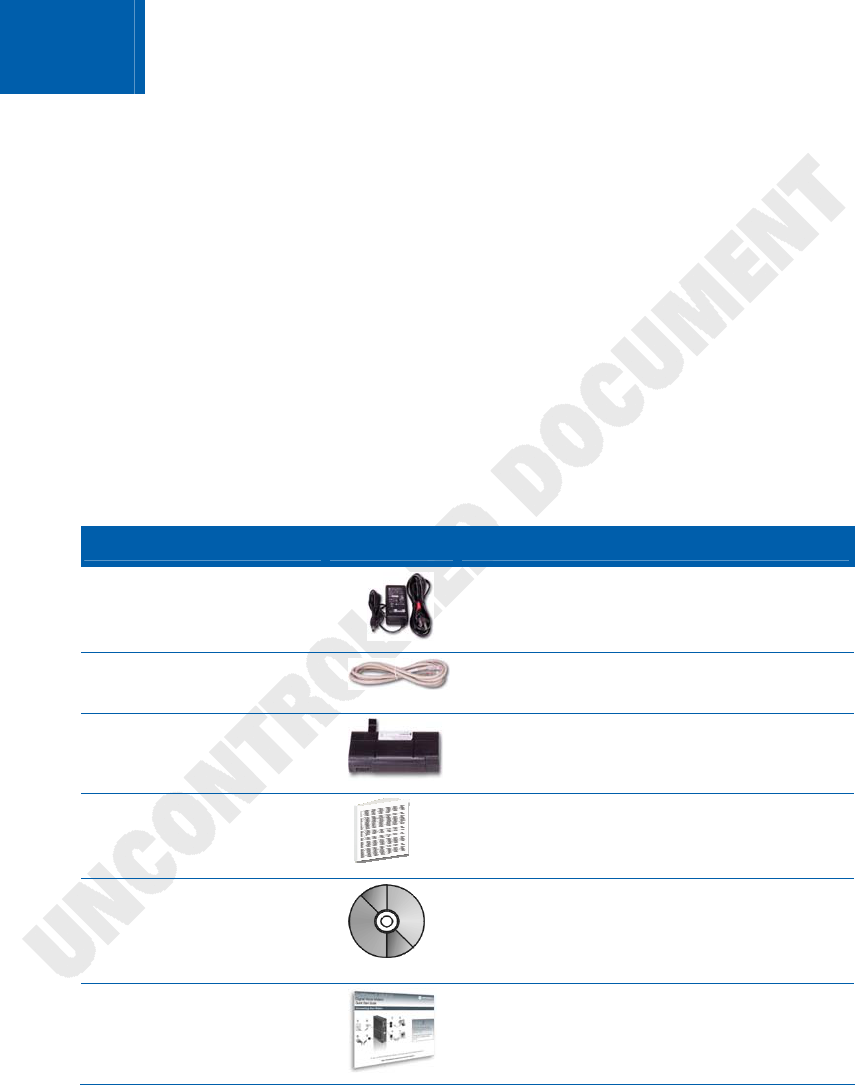
B
Introduction • Inside the Box
Motorola SURFboard SVG2501 Series Wireless Voice Gateway* • User Guide 1
550885-001-a
1 Introduction
The Motorola SURFboard® SVG2501 Wireless Voice Gateway is designed for use in
households with one or more computers capable of wireless and/or wired connectivity.
This guide provides product overview and setup information for the SVG2501. It also
provides instructions for installing the gateway and configuring the wireless, Ethernet,
router, DHCP, and security settings.
Note: All references to the SVG2501 throughout this guide also apply to the SVG2501U,
unless noted otherwise.
Inside the Box
Before installing the SVG2501, verify that the following items are included in the box
with the gateway. If you obtained the gateway from your service provider, some of the
included items may be different.
Item Description
Power Supply
Provides power via an AC electrical outlet
10/100Base-T Ethernet
Cable
Standard Category 5, or higher, cable for
connecting to the network
Battery
Provides backup power for the SVG2501
during a power outage
Software License &
Regulatory Card
Contains software license, warranty, and
safety information for the SVG2501
SVG2501 Installation
CD-ROM
Contains the SVG2501 Wi-Fi Installation
Wizard, software license agreement,
multi-language user guides, and USB drivers
(for SVG2501U models only).
SVG2501 Install Sheet
Provides basic information for setting up the
SVG2501

B
Introduction • Contact Information
Motorola SURFboard SVG2501 Series Wireless Voice Gateway* • User Guide 2
550885-001-a
You will need a 75-ohm coaxial cable with F-type connectors to connect the SVG2501 to
the nearest cable outlet. If a TV is connected to the cable outlet, you may need a 5 to
900 MHz RF splitter and two additional coaxial cables to use the TV and SVG2501.
Note: This product is also designed for IT power systems with phase to phase voltage
230VAC input.
Contact Information
For more information on Motorola consumer cable products, education, and support,
please visit the Motorola support website at:
4http://broadband.motorola.com/consumers/support
Minimum System Requirements
The SVG2501 is compatible with the following operating systems:
• Windows XP, Service Pack 2 or later
• Windows Vista, Service Pack 1 or later
• Mac 10.4 (Ethernet connection)
• Linux® (Ethernet connection)
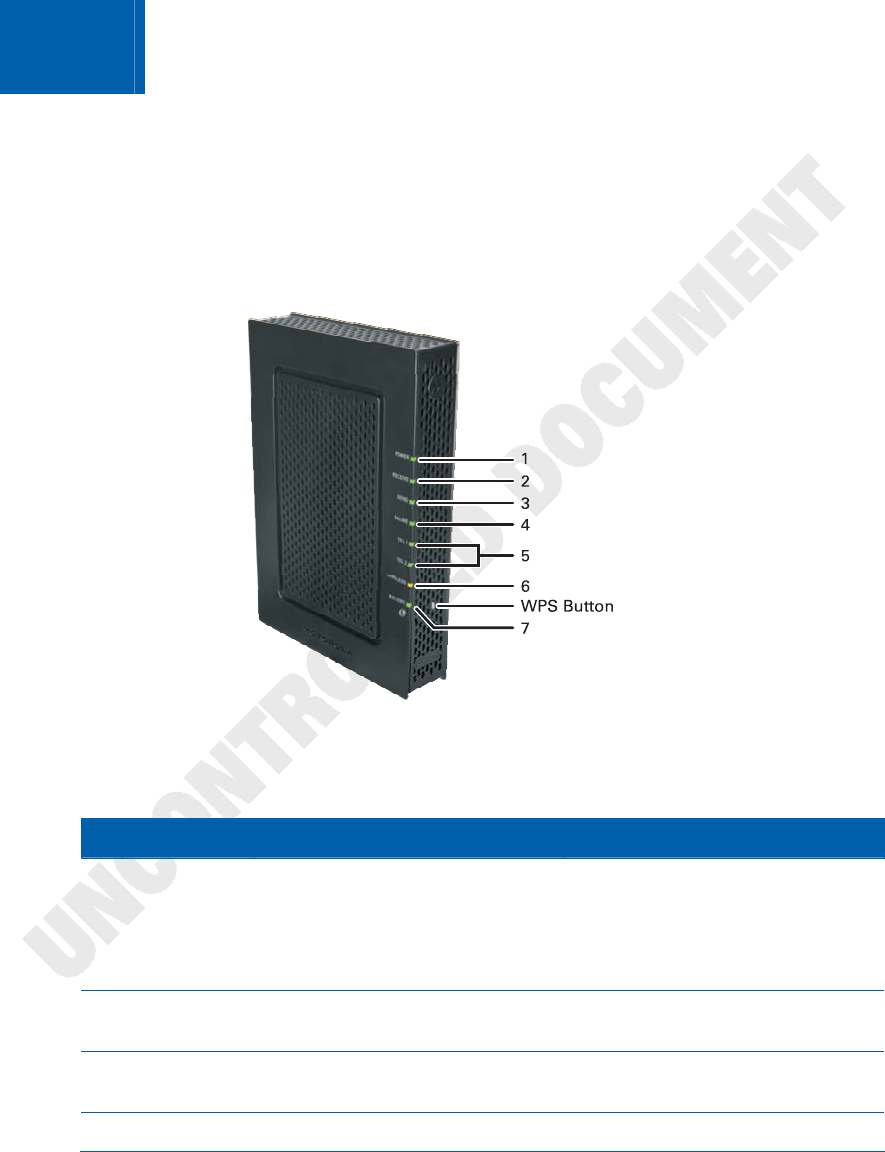
B
Product Overview • Front Panel
Motorola SURFboard SVG2501 Series Wireless Voice Gateway* • User Guide 3
550885-001-a
2 Product Overview
Front Panel
The SVG2501 front panel contains indicator lights and the WPS button, which is used to
configure a Wi-Fi Protected Security (WPS)-enabled device so that it automatically
connects to the SVG2501 wireless network.
The SVG2501 front panel LED indicators provide the following gateway status
information for power, communications, and errors:
LED Flashing On
1 POWER Battery power is connected
Note: When running on battery
power only, POWER LED will flash
and all remaining LEDS will turn
OFF to conserve power.
Green: AC power is connected
2 RECEIVE Scanning for a downstream
(receive) channel connection
Green: Downstream channel is
connected
3 SEND Scanning for an upstream (send)
channel connection
Green: Upstream channel is
connected
4 ONLINE Scanning for Internet connection Green: Startup process completed
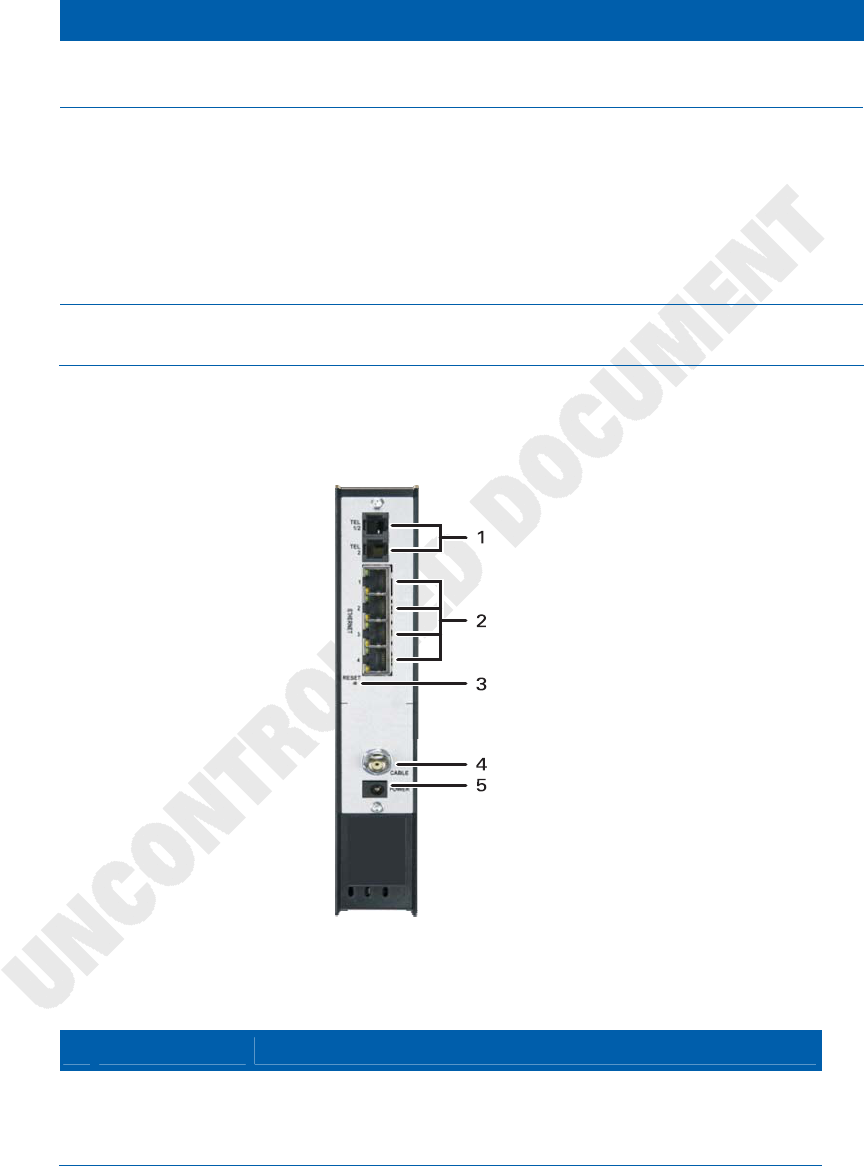
B
Product Overview • Rear Panel
Motorola SURFboard SVG2501 Series Wireless Voice Gateway* • User Guide 4
550885-001-a
LED Flashing On
5 TEL 1
TEL 2
Telephone is off-hook; dialing or
call in progress
Green: Telephone is connected and
activated; on-hook
6 WIRELESS Green: Wi-Fi enabled with
encrypted wireless data activity.
Long/short flash indicates wireless
pairing in progress.
Amber: Wi-Fi enabled with
unencrypted wireless data activity
Green: Wireless pairing successfully
established between the SVG2501
and another Wi-Fi enabled device on
your network — printer, PDA,
laptop, etc.
Amber: Wireless pairing was
successful. LED turns green after
five minutes.
7 BATTERY Battery is low Green: AC power is connected and
battery is fully charged
Rear Panel
Both the SVG2501 (shown above) and SVG2501U rear panels contain the following
cabling ports and connectors:
Item Description
1 TEL 1/2
TEL 2
VoIP connection for a single or two-line telephone
VoIP connection for a single-line telephone
Note: When running on battery power, only TEL1/2 port is active.

B
Product Overview • MAC Label
Motorola SURFboard SVG2501 Series Wireless Voice Gateway* • User Guide 5
550885-001-a
Item Description
2 ETHERNET
1 2 3 4
Use any Ethernet port to connect an Ethernet-equipped computer,
hub, bridge, or switch using an RJ-45 cable.
Green LED — Indicates a 100Base-T data rate connection
Amber LED — Indicates a 10Base-T data rate connection
• When LED is ON — Indicates there is no data traffic and a
connection is established
• When LED is FLASHING — Indicates data activity is detected on
the port
• When LED is OFF — Indicates the device is not powered on or
there is no Ethernet connection
Note: When running on battery power, the Ethernet connection will
shut off.
3 RESET Resets the wireless voice gateway.
It may take 5 to 30 minutes to find and lock on the appropriate
communications channels.
Press and hold the RESET button for five seconds or longer to
restore the factory default settings.
4 CABLE Coaxial cable connection to the cable wall outlet
5 POWER +14VDC power connector
* USB Available on SVG2501U models only
For Windows computers only — DO NOT connect a Mac or UNIX®
computer to the USB port.
MAC Label
The SVG2501 Media Access Control (MAC) label contains the MAC address which is a
unique, 48-bit value that identifies each Ethernet network device.
To receive data service, you must provide the MAC address marked HFC MAC ID to
your Internet service provider.
To receive VoIP service, you may have to provide the MTA MAC ID to your VoIP service
provider.
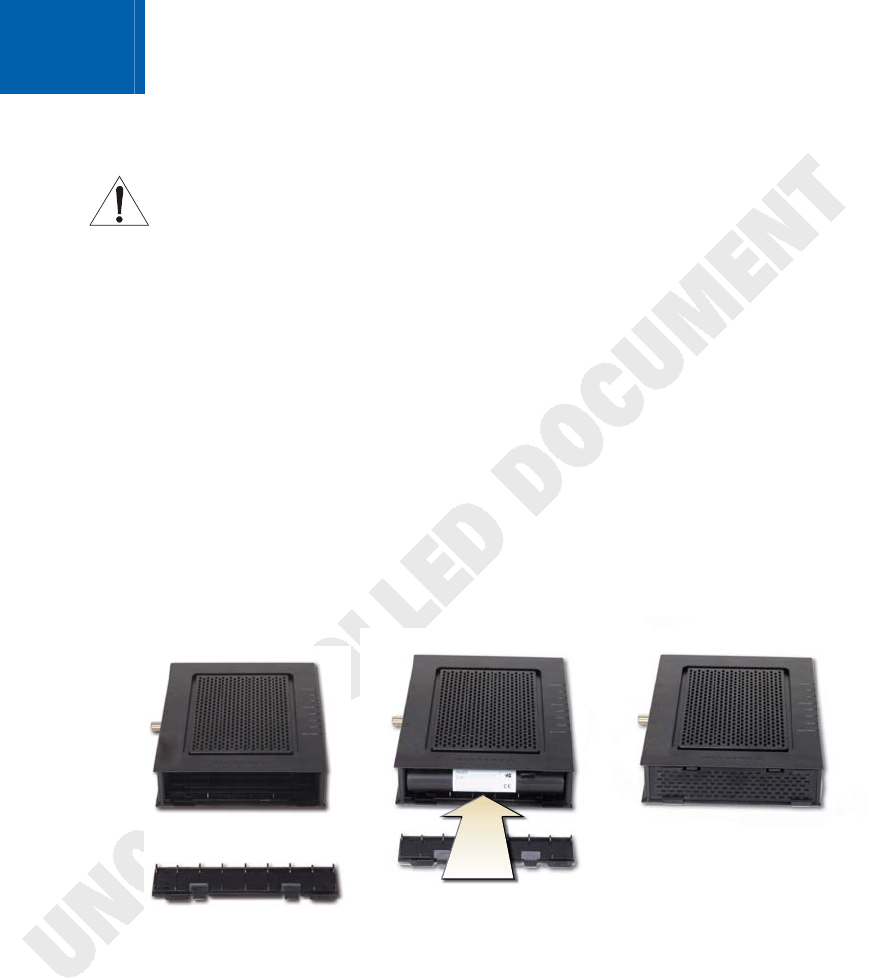
B
Cabling the Gateway • Installing the Battery
Motorola SURFboard SVG2501 Series Wireless Voice Gateway* • User Guide 6
550885-001-a
3 Cabling the Gateway
• This product is for indoor use only. Do not route the telephone lines,
USB and/or Ethernet cable(s) outside of the building. Exposure of the
cables to lightning could create a safety hazard and damage the
product.
• Before starting the battery installation, refer to 4Safety Requirements for
the SVG2501 Lithium-Ion Battery for information.
• The battery is not intended for everyday use, only for power backup
during a power outage.
• Install the battery before installing any other gateway components.
Installing the Battery
1. To remove the battery cover located on the bottom of the gateway, place the
gateway on its left side (LEDs facing up), press down on the upper two locking tabs
and then pull open the cover.
2. Line up the battery terminals and then slide the battery into the compartment until it
locks in place.
3. Set the battery cover into the bottom of the gateway and press down on the upper
two locking tabs, and then push the cover shut until the tabs snap into place.
Note: The battery may take up to 12 hours to reach a full charge.

B
Cabling the Gateway • Connecting the SVG2501
Motorola SURFboard SVG2501 Series Wireless Voice Gateway* • User Guide 7
550885-001-a
Connecting the SVG2501
• To reduce the risk of fire, use only No. 26 or larger UL Listed or CSA
Certified Telecommunication Line Cord or national equivalent to connect
a telephone line to your SVG2501.
• Contact your cable service provider before connecting your Motorola
wireless voice gateway to existing telephone wiring. DO NOT connect
the telephone cable from the TEL port to a traditional telephone (PSTN)
service; only connect it to a telephone.
Note: Before starting the installation, power on your computer and check that the
gateway is unplugged.
1. Connect the coaxial cable to a grounded cable TV outlet or splitter.
2. Connect the other end of the coaxial cable to the Cable connector on the gateway.
Hand-tighten the connectors to avoid damaging them.
3. Plug the power cord into the Power port on the gateway.
4. Plug the other end of the power cord into an electrical wall outlet.
This powers on the gateway. Allow the gateway 5- to 30 minutes to find and lock on
the appropriate communications channels.
5. Connect the Ethernet cable to the Ethernet port on your computer.
6. Connect the other end of the Ethernet cable to an Ethernet port on the gateway.
Repeat steps 5 and 6 for each additional computer.
7. Plug the telephone cord of a single- or two-line telephone into the telephone.
8. Plug the other end of the telephone cord into the TEL 1/2 port on the gateway.
Use the TEL 1/2 port to connect two-line telephones.
Note: Contact a VoIP service provider to activate this service.
9. For a second telephone, plug the telephone wire of a single-line telephone into the
TEL 2 port on the gateway.

B
Cabling the Gateway • Connecting the SVG2501
Motorola SURFboard SVG2501 Series Wireless Voice Gateway* • User Guide 8
550885-001-a
Figure 1 – SVG2501 Installation
10. Check that the LEDs on the front panel cycle through the following sequence:
Table 1 – SVG2501 LED Activity During Startup
LED Description
POWER • Turns on when AC power is connected to the gateway.
• Indicates that the power is connected properly.
RECEIVE • Flashes while scanning for the downstream receive channel.
• Changes to solid green when the receive channel is locked.
SEND • Flashes while scanning for the upstream send channel.
• Changes to solid green when the send channel is locked.
ONLINE • Flashes during the gateway registration and configuration.
• Changes to solid green when the gateway is registered.

B
Cabling the Gateway • Connecting the SVG2501U
Motorola SURFboard SVG2501 Series Wireless Voice Gateway* • User Guide 9
550885-001-a
Connecting the SVG2501U
• Before plugging in the USB cable on the SVG2501U, load the SVG2501
Installation CD in the CD-ROM drive on your computer.
• DO NOT connect the Ethernet and USB cables together on the same
computer at any time.
• To reduce the risk of fire, use only No. 26 or larger UL Listed or CSA
Certified Telecommunication Line Cord or national equivalent to connect
a telephone line to your SVG2501.
• DO NOT connect the telephone cable from the TEL port to a traditional
telephone service; only connect it to a telephone. Contact your cable
service provider before connecting the Motorola wireless voice gateway
to your existing telephone wiring.
Note: Before starting the installation, power on your computer and check that the
gateway power cord is unplugged.
1. Insert the SVG2501 Installation CD into the CD-ROM drive and load the applicable
USB driver.
2. Connect one end of the coaxial cable to the cable outlet or splitter.
3. Connect the other end of the coaxial cable to the Cable connector on the gateway.
Hand-tighten the connectors to avoid damaging them.
4. Plug the power cord into the Power port on the gateway.
5. Plug the other end of the power cord into an electrical wall outlet.
This powers on the gateway. You do not need to unplug the gateway when it is not
in use. The first time you plug in the gateway, allow it 5- to 30 minutes to find and
lock on the appropriate communications channels.
6. Connect the USB (not supplied) or Ethernet cable to the appropriate port on the
computer.
7. Connect the other end of the USB or Ethernet cable to the appropriate port on the
gateway.
If applicable, repeat steps 6 and 7 for each additional Ethernet connection.
8. Plug the telephone cord of a single- or two-line telephone into the telephone.
9. Plug the other end of the telephone cord of a single- or two-line telephone into the
TEL 1/2 port on the gateway.
Note: Contact a VoIP service provider to activate VoIP service.
10. For a second telephone, plug the telephone wire of a single-line telephone into the
TEL 2 port on the gateway.
11. Check that the LEDs on the front panel cycle through the proper sequence, see
SVG2501 LED Activity During Startup.
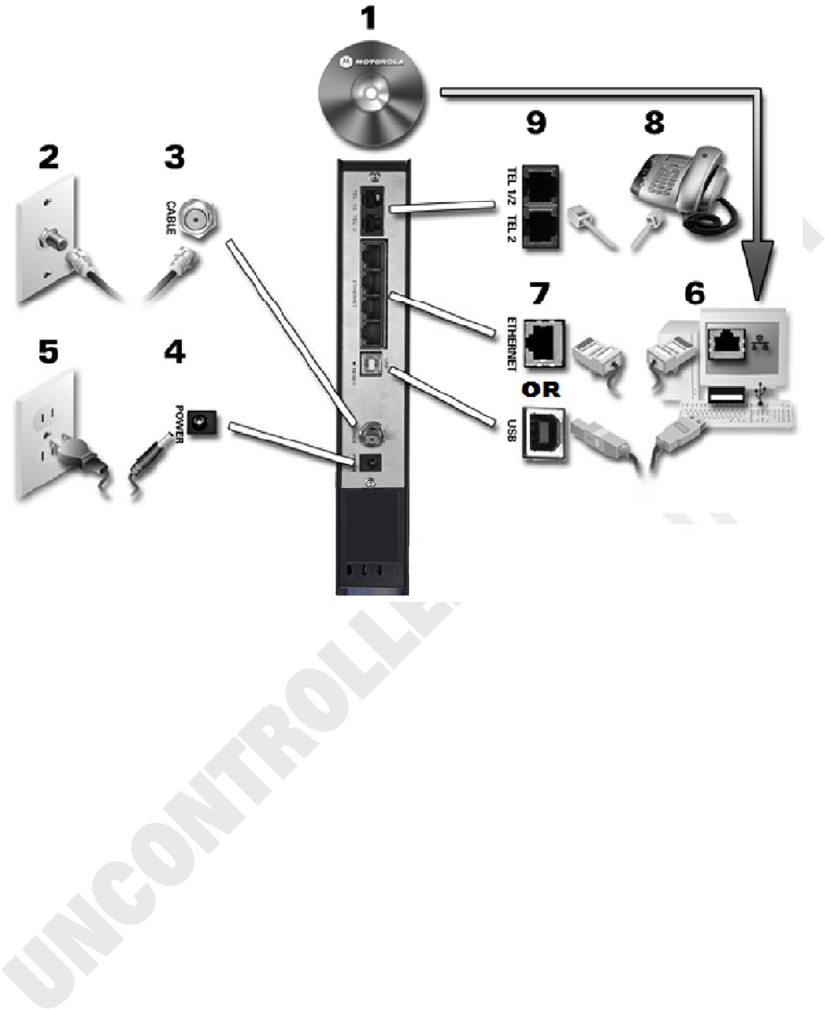
B
Cabling the Gateway • Wall Mounting the Gateway
Motorola SURFboard SVG2501 Series Wireless Voice Gateway* • User Guide 10
550885-001-a
Figure 2 – SVG2501U Installation
Wall Mounting the Gateway
If you choose to mount the wireless gateway on a wall, do the following before starting:
• Locate the unit as specified by the local or national codes governing residential or
business cable TV and communications services.
• Follow all local standards for installing a network interface unit/network interface
device (NIU/NID).
• Make sure the AC power plug is disconnected from the wall outlet and all cables are
removed from the back of the gateway before starting the installation.
• Decide if you are mounting the gateway horizontally or vertically.
Make sure you have the following items:
• Wall-mounting template
• Applicable screwdriver: Phillips or flathead
• Two M3.5 (#6) screws with a flat underside and maximum screw head diameter of
9.0 mm to mount the gateway.

B
Cabling the Gateway • Wall Mounting the Gateway
Motorola SURFboard SVG2501 Series Wireless Voice Gateway* • User Guide 11
550885-001-a
Note: Contact a qualified installer to determine the appropriate screw length needed
for mounting the gateway.
• See the dimensioned view below for the spacing needed between the screw head
and wall:
9.0 mm (0.35”) maximum
screw head diameter
2.6 mm (0.10”) maximum
screw head thickness
2.5 mm (0.10”) minimum
screw head to wall spacing
Note: If possible, mount the gateway to concrete, masonry, a wooden stud, or some
other solid wall material. Use anchor bolts if necessary (for example, if you mount the
unit on drywall).
Before drilling holes in the wall, check the structure for potential damage to water,
gas, or electrical lines.
1. Position and secure the wall mounting template on the wall to mark the holes.
There must be .10 inch (2.5 mm) between the wall and underside of the screw head.
2. The hole depth will be determined by the installer and by the type of hardware
he/she selects. i.e. As the (!) caution statement above indicates. Line #2 should be
removed or reworded to remind the installer to carefully select an appropriate depth
and diameter.
3. After mounting the gateway, reconnect the coaxial and Ethernet (or USB) cables.
4. Re-plug the power cord into the +14VDC Power connector on the gateway and the
electrical outlet.
5. Properly arrange the cables to prevent any safety hazards.
6. Verify the gateway is still securely attached to the wall.
Wall Mounting Template
You can print the following page to use as the wall mounting template.
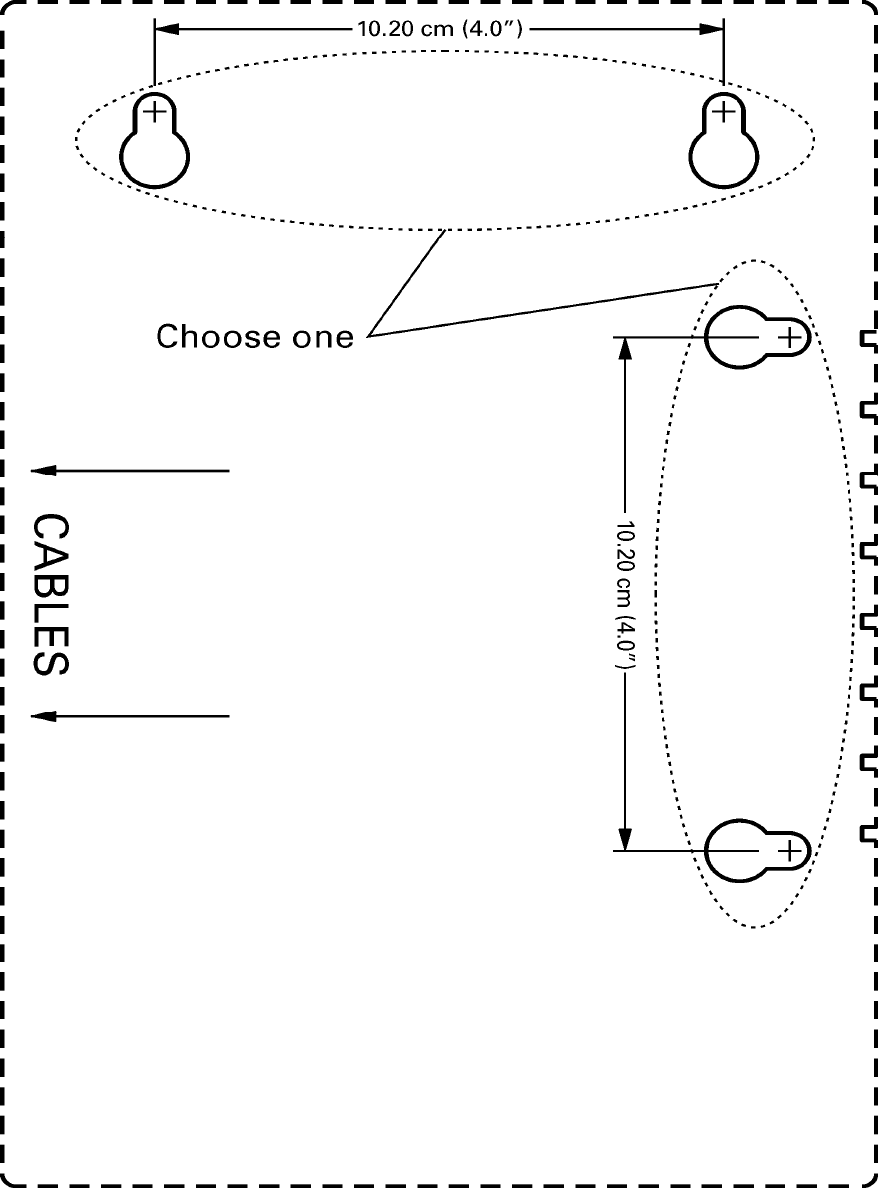
B
Cabling the Gateway • Wall Mounting the Gateway
Motorola SURFboard SVG2501 Series Wireless Voice Gateway* • User Guide 12
550885-001-a

B
Connecting to the Internet • Before You Begin
Motorola SURFboard SVG2501 Series Wireless Voice Gateway* • User Guide 13
550885-001-a
4 Connecting to the Internet
Before You Begin
After installing the wireless gateway, check that your computer can connect to the
Internet. For any problems connecting to the Internet, check the Troubleshooting section
for a possible solution. If there is still no connection, you may have to configure the
TCP/IP settings on the one or more computers connected to the gateway.
• To prevent unauthorized user access, change the default username and password
before proceeding. See Changing the Default Username and Password for
instructions.
• For security reasons, DO NOT configure your SVG2501 Wireless Voice Gateway
over a wireless network connection.
Use one of the following options to retrieve an IP address for your computer’s network
interface:
• Configure the statically-defined IP address and DNS address
• Automatically retrieve the IP address using the Network DHCP server.
Note: For UNIX or Linux systems, follow the instructions in the applicable user
documentation.
Configuring TCP/IP for Windows XP
1. Click Start and then click Settings.
2. Click Control Panel.
3. Double-click Network Connections to list the Dial-up and LAN or High-Speed
Internet connections.
4. Right-click the network connection for your network interface.
5. Select Properties from the drop-down menu to display the Local Area Connection
Properties window. Be sure Internet Protocol (TCP/IP) is checked.
6. Select Internet Protocol (TCP/IP) and click Properties to display the Internet
Protocol (TCP/IP) Properties window.
7. Select Obtain an IP address automatically and Obtain DNS server address
automatically.
8. Click OK to save the TCP/IP settings and exit the TCP/IP Properties window.
9. Close the Local Area Connection Properties window and then exit the Control Panel.

B
Connecting to the Internet • Configuring TCP/IP for Windows Vista
Motorola SURFboard SVG2501 Series Wireless Voice Gateway* • User Guide 14
550885-001-a
10. When you complete the TCP/IP configuration, go to Verifying the IP Address in
Windows XP.
Configuring TCP/IP for Windows Vista
1. Click Start and then click Settings.
2. Open the Control Panel.
3. Double-click Network and Internet to display the Network and Internet window.
4. Double-click Network and Sharing Center to display the Network and Sharing
Center window.
5. Click Manage network connections to display the LAN or High-Speed Internet
connections window.
6. Right-click the network connection for your network interface.
7. Select Properties to display the Local Area Connection Properties window.
Vista may prompt you to allow access to the Network Properties Options. If you see
the prompt, User Account Control -- Windows needs your permission to
continue, click Continue.
8. Select Internet Protocol Version 4 or 6 (TCP/IPv4 or v6) and click Properties to
display the Internet Protocol Properties window.
9. Select Obtain an IP address automatically and Obtain DNS server address
automatically.
10. Click OK to save the TCP/IP settings and close the Internet Protocol Version 4
(TCP/IPv4) Properties window.
11. Click OK to close the Local Area Connection Properties window.
12. Close the remaining windows and exit the Control Panel.
13. When you complete the TCP/IP configuration, go to Verifying the IP Address in
Windows Vista.
Verifying the IP Address
Windows XP
1. On the Windows taskbar, click Start.
2. Select Run to open the Run window.
3. Type cmd and click OK.
4. Type ipconfig and press Enter to display your IP configuration.
If an Auto-configuration IP address is displayed, that indicates possible broadband
network problems or an improper connection between your computer and the SVG2501.
The Auto-configuration IP address, ranging from 169.254.0.0 to 169.254.255.255, is
reserved for Automatic Private IP Addressing (APIPA).

B
Connecting to the Internet • Renewing the IP Address in Windows XP or Vista
Motorola SURFboard SVG2501 Series Wireless Voice Gateway* • User Guide 15
550885-001-a
This can occur if the gateway is configured to automatically obtain an IP address from a
Dynamic Host Configuration Protocol (DHCP) server. When Auto-configuration is
enabled, Windows will automatically assign an IP address if the gateway is unable to
obtain one. Because this automatically assigned IP address is not valid, you will not be
able to access the Internet using the gateway. Check the following:
• Your cable connections
• Whether you can see cable-TV channels on your television
After successfully verifying your cable connections and proper cable-TV operation, you
can renew your IP address, see Renewing Your IP Address.
Windows Vista
1. On the Windows taskbar, click Start.
2. Click All Programs.
3. Click Accessories.
4. Click Run to open the Run window.
5. Type cmd and click OK to open a command prompt window.
6. Type ipconfig and press Enter to display the IP Configuration.
If an Auto-configuration IP address is displayed, that indicates possible broadband
network problems or an improper connection between your computer and the SVG2501.
The Auto-configuration IP address, ranging from 169.254.0.0 to 169.254.255.255, is
reserved for Automatic Private IP Addressing (APIPA).
Renewing the IP Address in Windows XP or Vista
1. Open a command prompt window.
A. From the Windows taskbar, click Start.
B. Select Run to open the Run window.
C. Type cmd and click OK to open a command prompt window.
2. Type ipconfig /renew and press Enter. A valid IP address should appear indicating
that Internet access is available.
3. Type exit and press Enter to close the command prompt window.
If, after performing this procedure, your computer still cannot access the Internet, call
your cable provider.

B
Connecting to the Internet • Setting Up a Wi-Fi Network
Motorola SURFboard SVG2501 Series Wireless Voice Gateway* • User Guide 16
550885-001-a
Setting Up a Wi-Fi Network
Do the following to set up a Wi-Fi network using the WPS button on the SVG2501 front
panel:
1. Power on the SVG2501 Wireless Voice Gateway.
2. Power on all the WPS-enabled devices you want to have access to the network,
such as a PC, router, or telephone.
The Wi-Fi network will automatically detect the WPS devices.
4. Press and hold the WPS button on the SVG2501 for five seconds.
5. If applicable, press the WPS button on each additional WPS device.
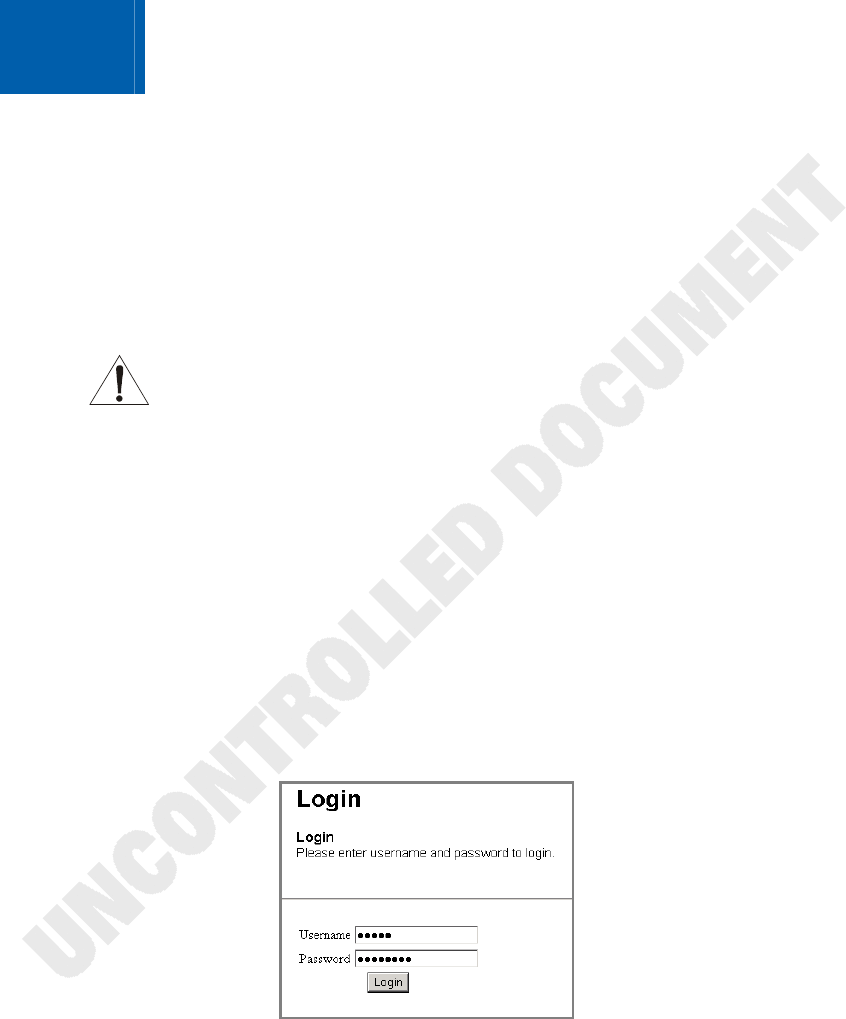
B
Using the Configuration Manager • Starting the Gateway Configuration Manager
Motorola SURFboard SVG2501 Series Wireless Voice Gateway* • User Guide 17
550885-001-a
5 Using the Configuration Manager
Use the SVG2501 Configuration Manager to change various default configuration
settings on your gateway.
Note: If your gateway was obtained as part of a service package, your service provider
may require alternative configuration methods. If you cannot access any of the HTML
pages in the Configuration Manager, please contact your service provider for more
information.
Read the following very important issues before proceeding:
• To prevent unauthorized access, change the default username and password
immediately after logging onto the SVG2501 Configuration Manager for the first
time. See Changing the Default Username and Password for more information.
• For security purposes, do not configure your SVG2501 Wireless Voice Gateway over
a wireless network connection.
Starting the Gateway Configuration Manager
1. Open any web browser on a computer connected to the gateway.
2. In the Address bar, type http://192.168.0.1 for the Configuration Manager’s IP
address, and then press Enter. The gateway login screen appears.
3. Type the default username and password. Both entries are case-sensitive.
Username: admin
Password: motorola
4. Click Login to open the SVG2501 Configuration Manager (CMGR).
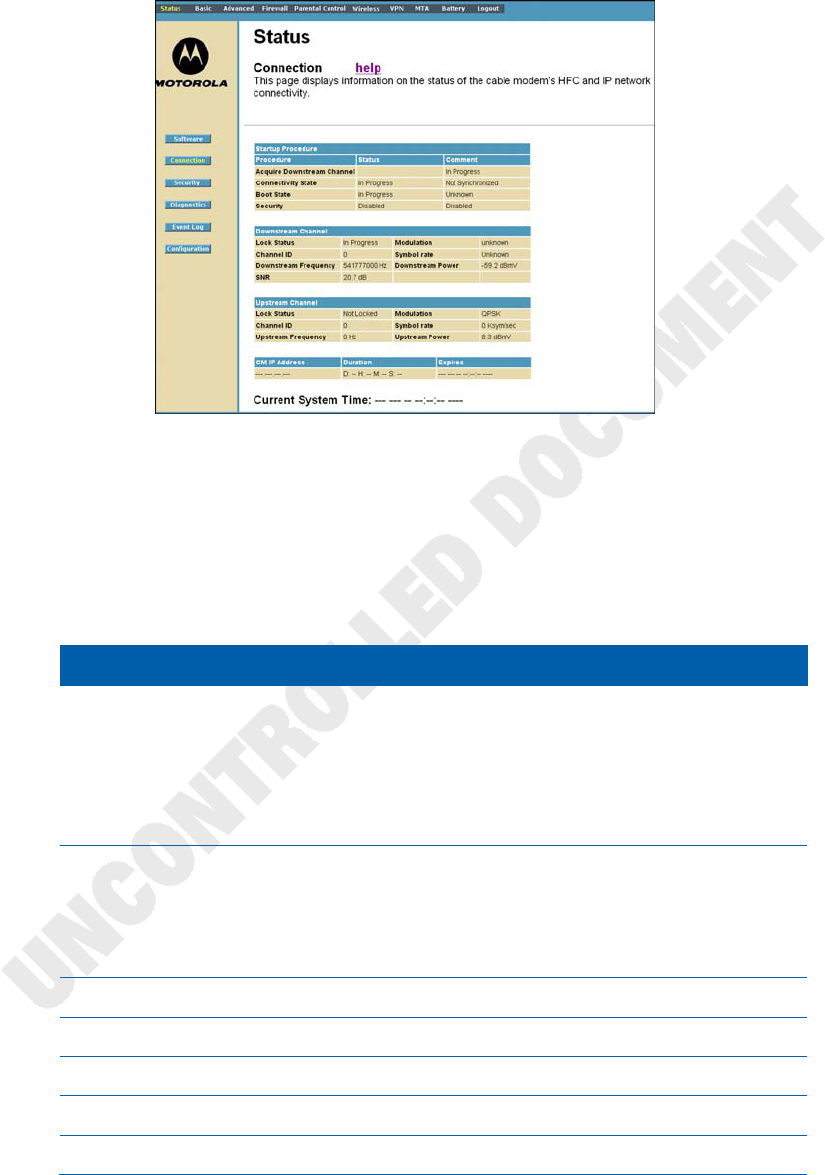
B
Using the Configuration Manager • Starting the Gateway Configuration Manager
Motorola SURFboard SVG2501 Series Wireless Voice Gateway* • User Guide 18
550885-001-a
Menu Options
The SVG2501 Configuration Manager Menu Options are displayed along the top of the
SVG2501 Configuration Manager screen. When a menu option is selected, a top-level
page for that option is displayed.
SVG2501 Configuration Manager Menu
Menu Options Function
Status Provides information about the SVG2501 hardware and software,
MAC address, gateway IP address, serial number, and related
information.
You can also monitor your cable system connection.
Additional pages provide diagnostic tools and allow you to change
your SVG2501 user name and password.
Basic Views and configures SVG2501 IP-related configuration data,
including Network Configuration, WAN Connection Type, DHCP,
and DDNS.
The Backup option allows you to save your SVG2501 configuration
on your computer.
Advanced Configures and monitors how the SVG2501 routes IP traffic.
Firewall Configures and monitors the SVG2501 firewall.
Parental Control Configures and monitors the SVG2501 parental control feature.
Wireless Configures and monitors SVG2501 wireless networking features.
VPN Configures and monitors SVG2501 operation with a VPN.
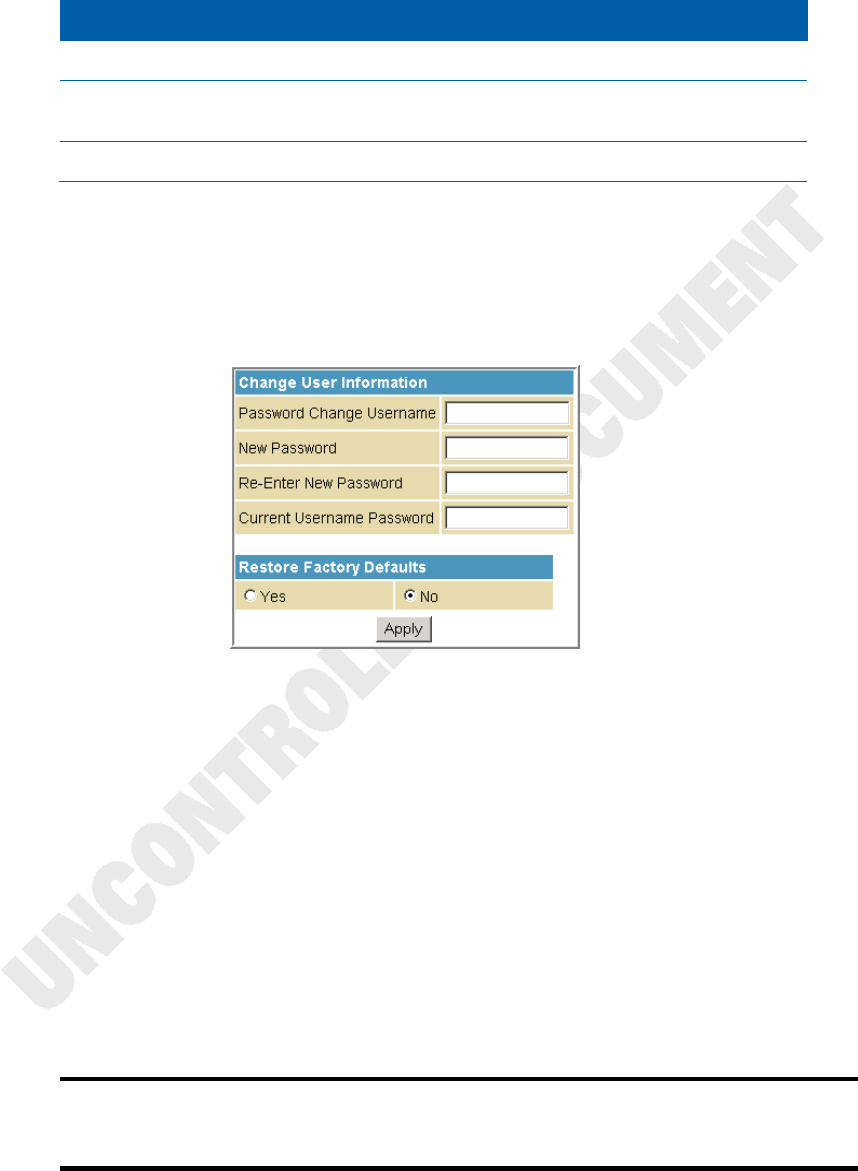
B
Using the Configuration Manager • Changing the Default Username and Password
Motorola SURFboard SVG2501 Series Wireless Voice Gateway* • User Guide 19
550885-001-a
Menu Options Function
MTA Monitors the telephone features of the SVG2501.
Battery Provides the current status information about the backup battery, if
installed.
Logout Closes the SVG2501 Configuration Manager.
Changing the Default Username and Password
From the Status menu, select Security. Complete each field and then click Apply to
save your changes.
• All entries are case-sensitive.
• For Password Change Username, type a new username.
• For Current Username Password, type the old password.
• Make sure No is selected for Restore Factory Defaults.
Note: Do not run Restore Factory Defaults to change the Username Password.
Restoring the Default Username and Password
1. From the Status menu, select Security.
2. Select Yes under Restore Factory Defaults.
3. Click Apply to reset the default username and password.
4. Log in again using the defaults.
WARNING: If you run Restore Factory Defaults, you will lose additional custom
configuration settings including your Parental Controls, Firewall, and Advanced settings.
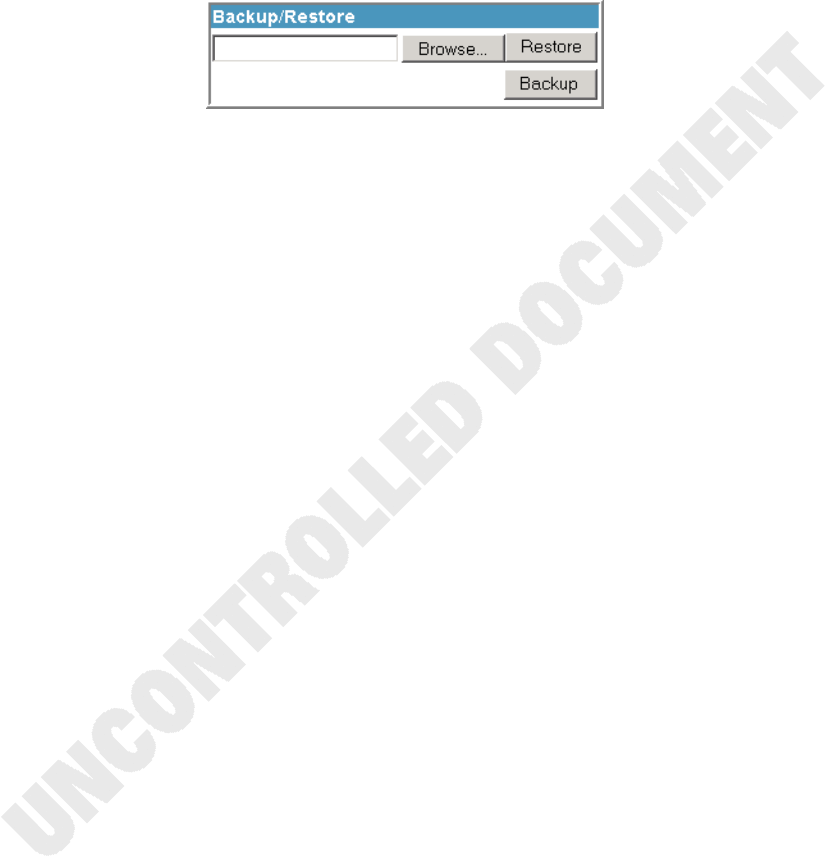
B
Using the Configuration Manager • Saving Your Gateway Configuration
Motorola SURFboard SVG2501 Series Wireless Voice Gateway* • User Guide 20
550885-001-a
Saving Your Gateway Configuration
You can save the current gateway settings on your computer.
1. From the Basic menu, select Backup.
2. Click Backup and then click OK.
3. Click Save.
4. Select the gateway configuration file — use the default, GatewaySettings.bin, or
select another file name.
5. Click Save.
Restoring Your Gateway Configuration
You can restore previously saved gateway settings on your computer.
1. From the Basic menu, select Backup.
2. To restore your previously saved gateway configuration, click Restore and then
select OK to reboot the gateway.
– or -
To select a different gateway configuration, click Browse to locate the file and then
click Open.
Click Restore and then click OK to reboot the gateway.
Retrieving Help
Help information is available for any menu option. It provides brief field descriptions for
each menu option page. To retrieve help, click help on that page. Below is a sample help
page for the Firewall Web Filter menu option.
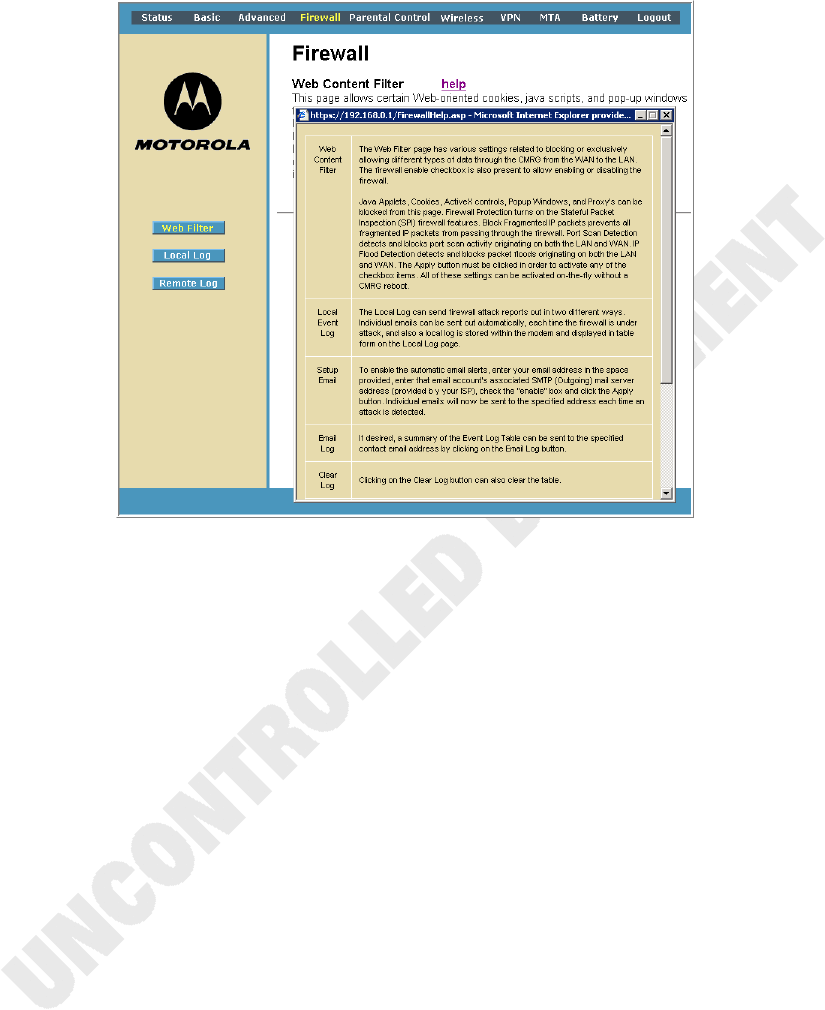
B
Using the Configuration Manager • Exiting the Gateway Configuration Manager
Motorola SURFboard SVG2501 Series Wireless Voice Gateway* • User Guide 21
550885-001-a
Exiting the Gateway Configuration Manager
• Click Logout on the SVG2501 Menu bar.

B
Troubleshooting • Solutions
Motorola SURFboard SVG2501 Series Wireless Voice Gateway* • User Guide 22
550885-001-a
A Troubleshooting
If the solutions listed here do not solve your problem, contact your service provider.
Before calling your service provider, try pressing the Reset button on the rear panel of
the SVG2501.
Note: Press RESET on the rear panel to restore the default settings. You will lose your
custom configuration settings, including Parental Control, Firewall, and Advanced
settings.
Resetting the SVG2501 may take 5- to 30 minutes. Your service provider may ask for the
status of the lights as described in Front-Panel LEDs and Error Conditions.
Solutions
Table 2 – Troubleshooting Solutions
Gateway Problem Possible Solution
Power light is off • Check that the SVG2501 is properly plugged into the electrical
outlet.
• Check that the electrical outlet is working.
• Press the RESET button on the rear panel.
Cannot send or
receive data
• On the front panel, note the status of the LEDs and refer to
Front-Panel LEDs and Error Conditions to identify the error. If
you have cable TV, check that the TV is working and the picture
is clear. If you cannot receive regular TV channels, the data
service will not function.
• Check the coaxial cable at the SVG2501 and wall outlet.
Hand-tighten if necessary.
• Check the IP address. Follow the steps for verifying the IP
address for your system described in Configuring TCP/IP. Call
your service provider if you need an IP address.
• Check that the Ethernet (or USB) cable is properly connected to
the SVG2501 and the computer.
• If a device is connected via the Ethernet port, check the ONLINE
LED to verify connectivity.

B
Troubleshooting • Front Panel LEDs and Error Conditions
Motorola SURFboard SVG2501 Series Wireless Voice Gateway* • User Guide 23
550885-001-a
Gateway Problem Possible Solution
Wireless client(s)
cannot send or receive
data
• Perform the first four checks in “Cannot send or receive data.”
• Check the Security Mode setting on the Wireless Primary
Network Page:
− If you enabled WPA and configured a passphrase on the
SVG2501, be sure each affected wireless client has the
identical passphrase. If this does not solve the problem,
check whether the wireless client supports WPA.
− If you enabled WEP and configured a key on the SVG2501, be
sure each affected wireless client has the identical WEP key.
If this does not solve the problem, check whether the client’s
wireless adapter supports the type of WEP key configured on
the SVG2501.
− To temporarily eliminate the Security Mode as a potential
issue, disable security.
• After resolving your problem, be sure to re-enable wireless
security.
• On the Wireless Access Control Page, be sure the MAC address
for each affected wireless client is correctly listed.
Slow wireless
transmission speed
with WPA enabled
• On the Wireless Primary Network Page, check whether the WPA
Encryption type is TKIP.
• If all of your wireless clients support AES, change the WPA
Encryption to AES.
Front Panel LEDs and Error Conditions
The SVG2501 front panel LEDs provide status information for the following error
conditions:
Table 3 – Front Panel LEDs and Error Conditions
LED Status If, During Startup: If, During Normal Operation:
POWER OFF SVG2501 is not properly plugged
into the power outlet
The SVG2501 is unplugged
RECEIVE FLASHING Downstream receive channel
cannot be acquired
The downstream channel is lost
SEND FLASHING Upstream send channel cannot
be acquired
The upstream channel is lost
ONLINE FLASHING IP registration is unsuccessful The IP registration is lost

B
Software License & Warranty • Software License
Motorola SURFboard SVG2501 Series Wireless Voice Gateway* • User Guide 24
550885-001-a
B Software License & Warranty
SURFboard SVG2501 Series Wireless Voice Gateway
Motorola, Inc.
Home & Networks Mobility Solutions Business (“Motorola”)
101 Tournament Drive
Horsham, PA 19044
Software License
IMPORTANT: PLEASE READ THIS SOFTWARE LICENSE (“LICENSE”) CAREFULLY BEFORE YOU INSTALL, DOWNLOAD
OR USE ANY APPLICATION SOFTWARE, USB DRIVER SOFTWARE, FIRMWARE AND RELATED DOCUMENTATION
(“SOFTWARE”) PROVIDED WITH MOTOROLA’S CABLE DATA PRODUCT (THE “CABLE DATA PRODUCT”). BY USING THE
CABLE DATA PRODUCT AND/OR INSTALLING, DOWNLOADING OR USING ANY OF THE SOFTWARE, YOU INDICATE
YOUR ACCEPTANCE OF EACH OF THE TERMS OF THIS LICENSE. UPON ACCEPTANCE, THIS LICENSE WILL BE A
LEGALLY BINDING AGREEMENT BETWEEN YOU AND MOTOROLA. THE TERMS OF THIS LICENSE APPLY TO YOU AND
TO ANY SUBSEQUENT USER OF THIS SOFTWARE.
IF YOU DO NOT AGREE TO ALL OF THE TERMS OF THIS LICENSE (I) DO NOT INSTALL OR USE THE SOFTWARE AND (II)
RETURN THE CABLE DATA PRODUCT AND THE SOFTWARE (COLLECTIVELY, “PRODUCT”), INCLUDING ALL
COMPONENTS, DOCUMENTATION AND ANY OTHER MATERIALS PROVIDED WITH THE PRODUCT, TO YOUR POINT OF
PURCHASE OR SERVICE PROVIDER, AS THE CASE MAY BE, FOR A FULL REFUND. BY INSTALLING OR USING THE
SOFTWARE, YOU AGREE TO BE BOUND BY THE PROVISIONS OF THIS LICENSE AGREEMENT.
The Software includes associated media, any printed materials, and any “on-line” or electronic documentation.
Software provided by third parties may be subject to separate end-user license agreements from the manufacturers of
such Software.
The Software is never sold. Motorola licenses the Software to the original customer and to any subsequent licensee for
personal use only on the terms of this License. Motorola and its 3rd party licensors retain the ownership of the
Software.
You may:
USE the Software only in connection with the operation of the Product.
TRANSFER the Software (including all component parts and printed materials) permanently to another person, but only
if the person agrees to accept all of the terms of this License. If you transfer the Software, you must at the same time
transfer the Product and all copies of the Software (if applicable) to the same person or destroy any copies not
transferred.
TERMINATE this License by destroying the original and all copies of the Software (if applicable) in whatever form.
You may not:
(1) Loan, distribute, rent, lease, give, sublicense or otherwise transfer the Software, in whole or in part, to any other
person, except as permitted under the TRANSFER paragraph above. (2) Copy or translate the User Guide included with
the Software, other than for personal use. (3) Copy, alter, translate, decompile, disassemble or reverse engineer the
Software, including but not limited to, modifying the Software to make it operate on non-compatible hardware. (4)
Remove, alter or cause not to be displayed, any copyright notices or startup message contained in the Software

B
Software License & Warranty • Warranty Information
Motorola SURFboard SVG2501 Series Wireless Voice Gateway* • User Guide 25
550885-001-a
programs or documentation. (5) Export the Software or the Product components in violation of any United States export
laws.
The Product is not designed or intended for use in on-line control of aircraft, air traffic, aircraft navigation or aircraft
communications; or in design, construction, operation or maintenance of any nuclear facility. MOTOROLA AND ITS 3RD
PARTY LICENSORS DISCLAIM ANY EXPRESS OR IMPLIED WARRANTY OF FITNESS FOR SUCH USES. YOU REPRESENT
AND WARRANT THAT YOU SHALL NOT USE THE PRODUCT FOR SUCH PURPOSES.
Title to this Software, including the ownership of all copyrights, mask work rights, patents, trademarks and all other
intellectual property rights subsisting in the foregoing, and all adaptations to and modifications of the foregoing shall
at all times remain with Motorola and its 3rd party licensors. Motorola retains all rights not expressly licensed under
this License. The Software, including any images, graphics, photographs, animation, video, audio, music and text
incorporated therein is owned by Motorola or its 3rd party licensors and is protected by United States copyright laws
and international treaty provisions. Except as otherwise expressly provided in this License, the copying, reproduction,
distribution or preparation of derivative works of the Software, any portion of the Product or the documentation is
strictly prohibited by such laws and treaty provisions. Nothing in this License constitutes a waiver of Motorola’s rights
under United States copyright law.
This License and your rights regarding any matter it addresses are governed by the laws of the Commonwealth of
Pennsylvania, without reference to conflict of laws principles. THIS LICENSE SHALL TERMINATE AUTOMATICALLY if
you fail to comply with the terms of this License.
Motorola is not responsible for any third party software provided as a bundled application, or otherwise, with the
Software.
U.S. GOVERNMENT RESTRICTED RIGHTS
The Product and documentation is provided with RESTRICTED RIGHTS. The use, duplication or disclosure by the
Government is subject to restrictions as set forth in subdivision (c)(1)(ii) of The Rights in Technical Data and Computer
Software clause at 52.227-7013. The contractor/manufacturer is Motorola, Inc., Home & Networks Mobility Solutions
Business, 101 Tournament Drive, Horsham, PA 19044.
Warranty Information
SURFboard SVG2501 Wireless Voice Gateway
Home & Networks Mobility (“Motorola”)
What is my limited warranty? A limited warranty for this Product (including Software) is provided by Motorola to your
distributor, cable operator, or Internet service provider, as applicable. Please contact your cable operator or Internet
service provider (“Service Provider”) for details. Motorola does not warrant that any Software will perform error-free or
without bugs. Motorola’s warranty shall not apply: (i) to any Product subjected to accident, misuse, neglect, alteration,
Acts of God, improper handling, improper transport, improper storage, improper use or application, improper
installation, improper testing, or unauthorized repair; or (ii) to cosmetic problems or defects which result from normal
wear and tear under ordinary use, and do not affect the performance or use of the Product. Motorola’s warranty applies
only to a Product that is manufactured by Motorola and identified by Motorola-owned trademarks, trade names, or
product identification logos affixed to the Product. MOTOROLA DOES NOT WARRANT THIS PRODUCT DIRECTLY TO
YOU, THE END USER. EXCEPT AS DESCRIBED IN THIS SECTION “WARRANTY INFORMATION,” THERE ARE NO
WARRANTIES OR REPRESENTATIONS OF ANY KIND RELATING TO THE PRODUCT, EXPRESS, IMPLIED, OR
STATUTORY, INCLUDING BUT NOT LIMITED TO IMPLIED WARRANTIES OF MERCHANTABILITY, FITNESS FOR A
PARTICULAR PURPOSE, OR WARRANTY AGAINST INFRINGEMENT. MOTOROLA IS NOT RESPONSIBLE FOR, AND
PROVIDES “AS IS,” ANY SOFTWARE SUPPLIED BY 3RD PARTIES.
What additional provisions should I be aware of? Because it is impossible for Motorola to know the purposes for which
you acquired this Product or the uses to which you will put this Product, you assume full responsibility for the selection

B
Software License & Warranty • Warranty Information
Motorola SURFboard SVG2501 Series Wireless Voice Gateway* • User Guide 26
550885-001-a
of the Product for its installation and use. While every reasonable effort has been made to insure that you will receive
a Product that you can use and enjoy, Motorola does not warrant that the functions of the Product will meet your
requirements or that the operation of the Product will be uninterrupted or error-free. MOTOROLA IS NOT RESPONSIBLE
FOR PROBLEMS OR DAMAGE CAUSED BY THE INTERACTION OF THE PRODUCT WITH ANY OTHER SOFTWARE OR
HARDWARE.
How long does this Limited Warranty last? Contact your Service Provider for details.
What you must do to obtain warranty service. For Product customer service, technical support, warranty claims,
questions about your Internet service or connection, contact your Service Provider. ALL WARRANTIES ARE VOID IF THE
PRODUCT IS OPENED, ALTERED, AND/OR DAMAGED.
THESE ARE YOUR SOLE AND EXCLUSIVE REMEDIES for any and all claims that you may have arising out of or in
connection with this Product, whether made or suffered by you or another person and whether based in contract or tort.
IN NO EVENT SHALL MOTOROLA BE LIABLE TO YOU OR ANY OTHER PARTY FOR ANY DIRECT, INDIRECT, GENERAL,
SPECIAL, INCIDENTAL, CONSEQUENTIAL, EXEMPLARY OR OTHER DAMAGES ARISING OUT OF THE USE OR INABILITY
TO USE THE PRODUCT (INCLUDING, WITHOUT LIMITATION, DAMAGES FOR LOSS OF BUSINESS PROFITS, BUSINESS
INTERRUPTION, LOSS OF INFORMATION OR ANY OTHER PECUNIARY LOSS), OR FROM ANY BREACH OF WARRANTY,
EVEN IF MOTOROLA HAS BEEN ADVISED OF THE POSSIBILITY OF SUCH DAMAGES. IN NO CASE SHALL MOTOROLA’S
LIABILITY EXCEED THE AMOUNT YOU PAID FOR THE PRODUCT.
Motorola’s warranty is governed by the laws of the Commonwealth of Pennsylvania, excluding its conflict of laws
principles and excluding the provisions of the United Nations.

m
Motorola, Inc.
101 Tournament Drive
Horsham, PA 19044 U.S.A.
http://www.motorola.com
MOTOROLA and the Stylized M logo are registered in the US Patent and Trademark Office. SURFboard is a registered
trademark of General Instrument Corporation, a wholly owned subsidiary of Motorola, Inc. All other product or service
names are the property of their respective owners. ©2009 Motorola, Inc. All rights reserved.
550885-001-a 12/2009